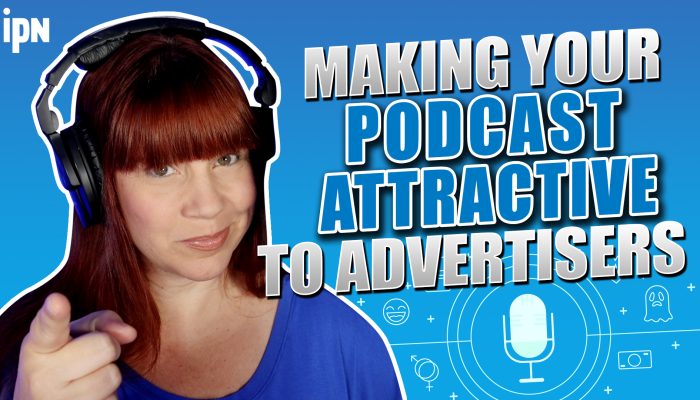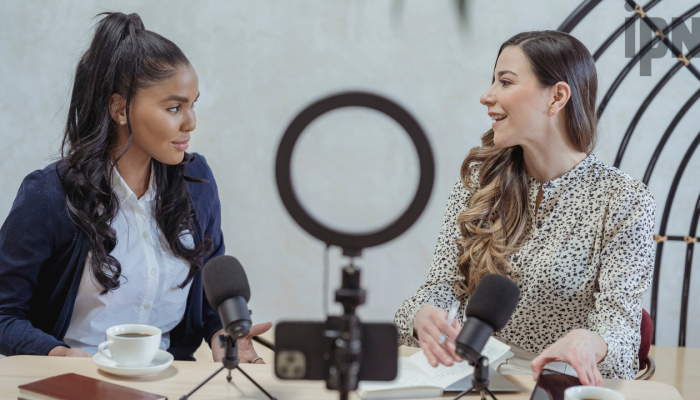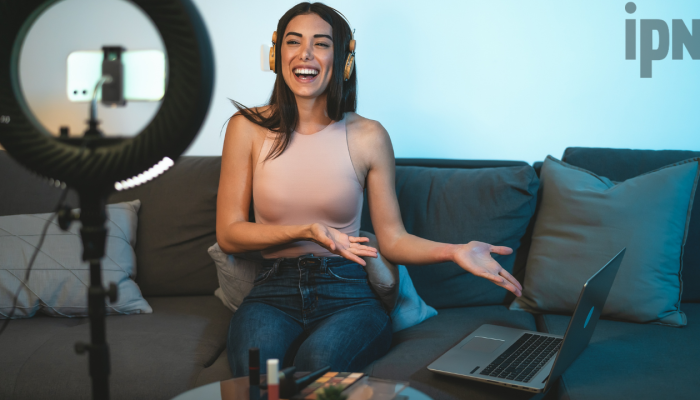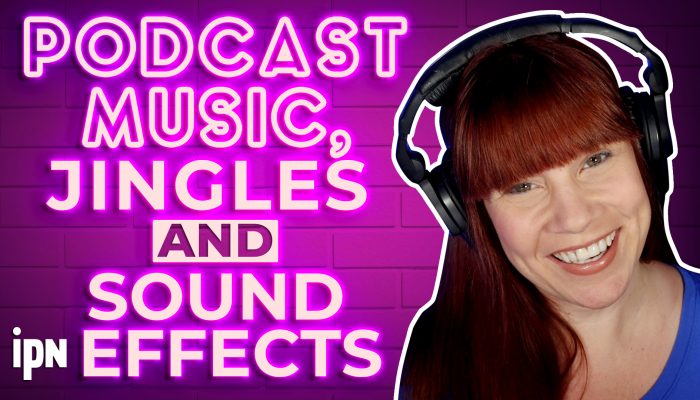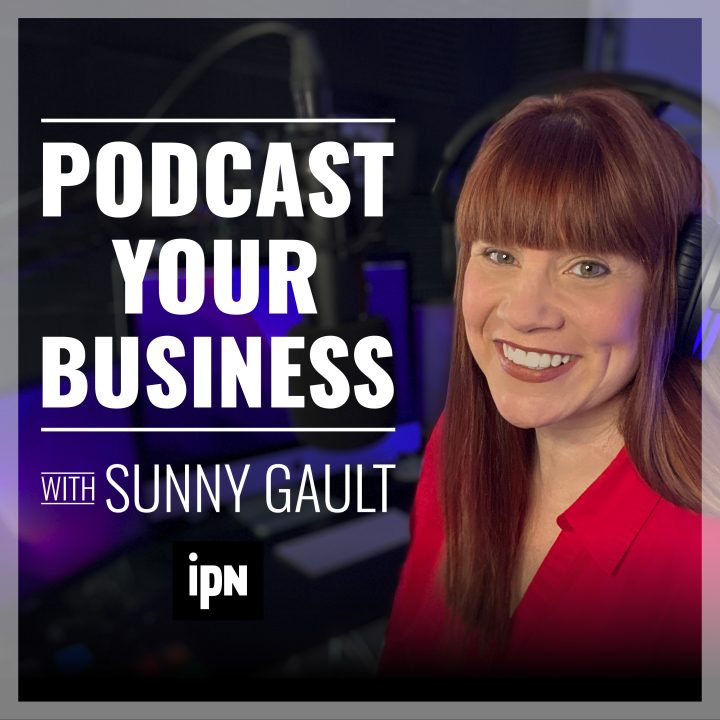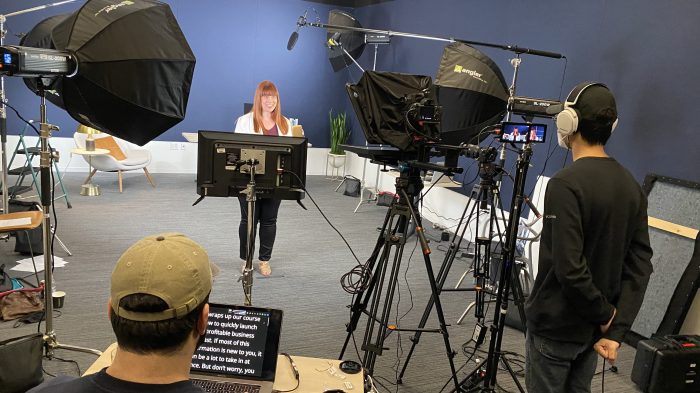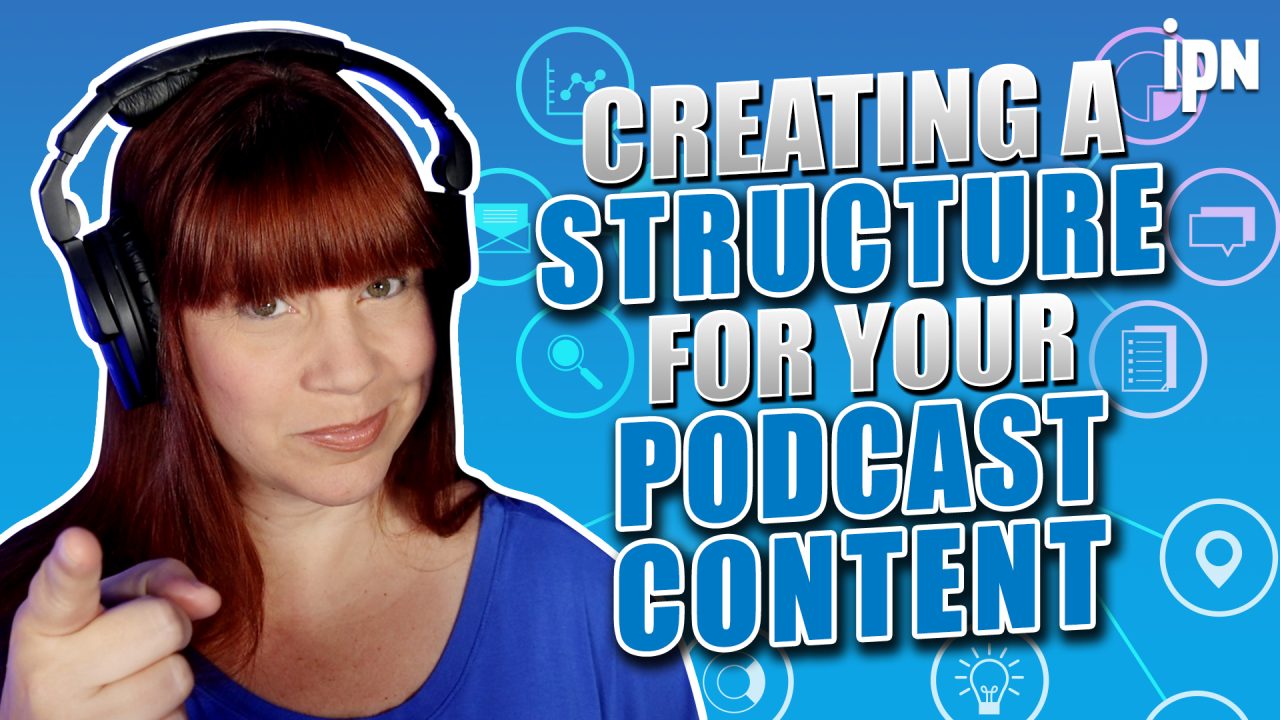
How do you format your individual episodes?
If you want listeners to keep coming back and listening to your show, then you need to have a solid episode format. This is the structure for your podcast, and it’s something most people are subconsciously looking for when they’re listening to your show. If you don’t have it, they may stop listening and they may not even know why. Having that structure helps guide your audience through the show so they know what to expect. So, what are the main components of a typical podcast episode, and where do you have some wiggle room so you can still be creative? Today we’re talking about creating a structure or format for your podcast episodes.
Here’s what we’re going to discuss…
- How long should your podcast episodes be?
- What should be included in your episode intro?
- How do you incorporate segments within your episodes?
- Where should you put commercials and promos?
- What role does music play in your episodes?
- How do you wrap up your show and say goodbye?
Looking for music for your podcast? Save 10% on Soundstripe when you use our promo code PODCAST!
Sample Podcast Script
Here’s a sample podcast script and outline I’ve been using to produce amazing interview-based podcasts for nearly two decades!

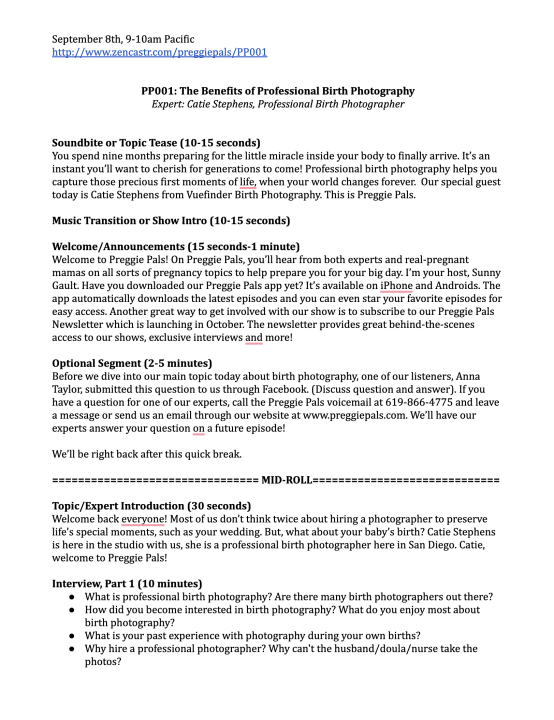
Episode Transcript
0:01
If you want listeners to keep coming back and listening to your show, then you need to have a solid episode format. This is the structure for your podcast. And it’s something most listeners are subconsciously looking for when they’re listening to your show. If you don’t have it, they may stop listening. And they may not even know why. But having that structure helps guide your audience through the show, so they know what to expect. So what are the main components of a typical podcast episode? And where do you have some wiggle room so you can still be creative? Today we’re talking about creating a structure or format for your podcast episodes. Take it away, Mister radio man. Podcast Your Business.
0:50
Hello, everybody. Welcome back to another episode of Podcast Your Business. My name is Sunny Gault. I’m a podcast coach and mentor and I have been doing this whole podcasting thing for 17 years, I think I’m about ready to switch and say 18. I’m right on the border there. I’m also the founder and CEO of a company called Independent Podcast Network. And we help all sorts of podcasters whether you are brand new to this whole thing called podcasting, or you’ve been doing this a long time, we put out a lot of free content. So I encourage you to check us out at https://independentpodcast.network. And if you’re ready to make some money with your show, we can help you with advertisers as well. But today, I am here to help you create amazing podcasts for your business. And we do this by mastering the five P’s of podcasting. Thank you, Mister radio man. So the five P’s are a concept that I created when I was working on my very first podcasting course this was back in like 2020, I think. And I thought, okay, how do people actually create successful shows, and there were different kinds of categories that I thought about. And there’s, you know, a lot you can learn within those categories. But the categories are the five P’s. And they are prep, plan, produce, promote, and profit. So again, there’s a lot you can learn within those five Ps. But if you master them, then you really know what you’re doing. And as a result, you’re going to have a successful podcast. So in each episode for Podcast Your Business, we break down one of these Ps, something that’s in one of these Ps, if that makes sense. Feel like I’m saying PS a lot today. All right, Mr. radio man, which of the five Ps are we talking about today? Plan.
2:41
That’s right. So after you have decided, yeah, I’m really gonna do this whole podcasting thing, then you need to really start thinking about, well, what kind of show are you going to do? And I think when it comes to thinking about the structure of your show, that that needs to happen in the beginning, because there’s a lot of other things that can be impacted by that, which is why I put this in the plan section. Now, quick caveat. Can you change the structure of your podcast, let’s say you’re listening to this, and you’ve already got 20 3050, whatever episodes out there, you can, okay, and people have done this before they’ve gotten a little bit bored with their format, and you can change things up. But for today, we are going to pretend that you are in the early stages of creating your podcast. And you’re just now starting to think about all of this. So back in episode 44, we’re now at 63. So it was about 20 episodes ago, we did an episode called “Creating a show format for your podcast”. And in doing research for that episode, I learned something really important. I learned that the term show format can mean a lot of different things. Because if you just go searching for that, you’re going to find a lot of information. So as I was researching that episode, I thought, Oh, we actually need multiple episodes to talk about show format. In that initial episode, Episode 44. We talked about an over arcing format for your entire podcast. So this would be things like should you do an audio podcast versus a video podcast? Should you do a solo episode? Are you going to have a co host? Or maybe some sort of panel like a roundtable panel discussion? Are you going to interview people? Or is it just going to involve the conversations that people on the show? Talk about so no external people? Are you going to have a scripted show? Is it non scripted? So all of that kind of information? If you’re looking for that, go back to Episode 44. Again, it’s called “Creating a show format for your podcast”. Once I did that episode, I thought oh, we really need to get into the nitty gritty of how do you structure your podcast episodes and that is what we’re going thing to talk about today. Because just like the format for your overall podcast, your episodes need to have a structure as well, so your audience knows what to expect. So you know what to expect.
5:14
In today’s episode, let’s talk about the things we’re going to go over. So we’re going to talk briefly about how long your podcast episode should be. We did a whole episode on this, but you need to have that information before you really start figuring out okay, now what’s gonna go inside this episode, we’re going to talk about your episode, intro and things to consider putting into your episode, your intro, we are going to talk about incorporating segments within your episodes. And we’ll talk more about exactly what that is. But overall, this really helps with the flow of your show. So it’s not just one big piece of content. We’re going to talk about where to put commercials and promos. We’re going to talk about the role that music plays in your episode and how can help with transitions and things like that. And then we’ll talk about how to wrap up your show, meaning your episode and how do you say goodbye. That’s the basic structure that we’re going to go over today. And we’re gonna get started on all of that right after this quick break. Okay, let’s just dive into this because I have a ton of information to go over. And I don’t want this episode to get too long. So while back we did in fact, this was just a handful of episodes, I think less than 10 episodes, we talked about the length of your podcast episode, How long should your podcast episode be? So I’m not going to go into a ton of detail on that in this episode. But you do need to know how long your episode is going to be at least a ballpark? Before you can really figure out what your format is. So what we talked about in that episode, that previous episode, is that the bulk of podcasts right now in 2023 are between 15 to 45 minutes long, the majority, there are 15% that go a little bit longer between 45 minutes and 60 minutes long. Now that’s just what’s out there right now. And trends change, things change, pandemics app in, whatever, there are a lot of outside influences that could impact this long term. But right now, it does make sense to kind of go along with what podcast listeners already expect. Can you go against the grain? Yes, you can, you can have a five minute episode. Maybe that is what your whole thing is about. Maybe you do motivational talks. And it’s a five minute pep talk that you do with people as they start their day, that can still work. And there are podcasts out there that are three hours or whatever long. But generally speaking, most are somewhere between, you know, 15 minutes to 45 minutes long. So determine your length before you start planning the format for your episodes. Now we’re going to go through and I’m going to try to do this chronologically, like how you would hear it play out in an episode, at least I’m going to start doing that. And then things get a little a little bit more complicated towards the end. But let’s talk about these different parts of your episode and things to consider.
8:20
Starting with your show intro. Now your show intro that can mean a lot of different things. So let’s just break this down. The whole point of a show intro is to get people interested in your episode as quickly as possible. And I would say within the first 10 Maybe 30 seconds, okay, but really try as quickly as possible to have something in there so that someone listening can tell if this is a good episode for them to listen to. Here are some do’s and don’ts. Okay. And trust me, I have made all of these mistakes. Okay, so I speak from experience, what I don’t want you to do is have some sort of pre recorded intro that takes, you know, 30 seconds. And that’s how all of your episodes start. There is nothing unique about it. It might be something customized that you did. But you just don’t want to start out all your episodes exactly the same. It’s boring, and it’s predictable. Okay, so please don’t do that. If you do have something pre recorded that you play, I would encourage you to just hold off a little bit until you play it. Or if you absolutely have to do it right off the top, make it super quick 510 seconds, whatever. But here are some things that you may want to consider doing because they have proven to be effective in the past, having some sort of brief intro explaining what the episode is about. Do that as soon as possible doesn’t have to be super elaborate. But again for the P But they’re just kind of scrolling through and pushing play. This gives them a good idea. If they’re listening to the right type of episode, are you going to be talking about things that they might be interested in? Another tactic that works really well is taking a sound bite from later on in the show an interesting soundbite. Let me preface that, and playing it at the top of the show. Now, I have heard people do this where it’s a little confusing. You’re like, Wait, did this episode just start? Or is this just a teaser? And I believe that’s because the person didn’t use music and things like that to help ease into this. If you’re going to use some sort of soundbite, keep it short and sweet, 20 seconds, something like that. Because again, if it’s a minute or two minutes long, people are going to think you just started your show. And that’s well past the 10 to 30 seconds, I said that you need in order to impress them. So please don’t do that. Okay, but those sound bite teasers have worked really well. It’s like, oh, that’s a really cool thing. I want to hear more about that. You can also use that for those of you doing audio grams, it can serve as a double purpose, because you can use that as your audiogram as well. Okay, what else could be in your intro? Sometimes I get questions about having something customized. Like, you know, having a voiceover artists do something for you, you know, do you need a theme song? The answer’s no to both. In fact, I really discourage people having some sort of voiceover artists doing their intro. Unless you just feel completely uncomfortable doing it. Okay. But if you’re going to do a podcast episode, the easiest thing to do is maybe have some sort of pre recorded, you know, Intro if you want keeping it short, of course. But do it yourself. I mean, you’re already recording a podcast episode, the most frustrating thing I see is when you have this very professional voiceover artist talking and then you hear it kind of gives you an idea of what the quality is going to be at least you think. And then the actual episode plays and the audio is crap. Right? And you’re like, wait, I feel like I’ve been hoodwinked. Because you had a really great intro here. I thought this was going to be a decent quality podcast. But it stinks. Like you’re not even using a professional microphone, what’s going on here? So I come across this all the time, when I am reviewing shows to invite to be part of our network. I’m like, Oh, great intro, this is gonna be a good show. And I’m like, Well, okay, and so listeners feel that way as well. So I don’t recommend that you get some elaborate voiceover artists to do it. If you want something pre recorded, do it yourself, Do you need a theme song? I have used theme songs in the past. And it doesn’t mean that you got to pay a lot of money for some, you know, contemporary song this on the radio. That’s not what I’m talking about. But having a consistent song that people associate with your show can be a good thing for my parenting shows, all of those shows. Now, this was done a million years ago, okay, before I really knew a lot about podcasting. And I was taking a lot of cues from what I knew about television and radio were theme songs are a thing, okay. But we figured out a song. And we had like different people saying different things in the beginning, like funny parenting sayings and things like that funny things you say when you’re pregnant, you know, funny things people say about, you know, parenting twins and things like that. And so we had, and still do, because the podcasts are still out there. We had the song, and then we edited in these little sound bites, if you will. But those intros are 30 seconds long. Now, that’s not the first thing people hear the first thing they hear is a little bit of music with someone explaining what they’re going to learn in the episode. And then you hear the theme song, if you will, which is 30 seconds, that’s a long time. And then it gets into the heart and soul of the podcast. If I were doing this over again, I would make that theme song way, way shorter. So it’s okay to have something like that. But even here with podcast, your business, I don’t have a theme song. I tried to make sure that the songs used in the beginning are different each time and I’m just telling you what the show is about. So you may want to rewind, go back to the beginning and listen to how I do it. So that’s another way of incorporating music because that can be helpful in really, you know, getting your audience’s attention and and using it wisely. But again, none of that is really needed. What’s most important is that you get to the content as quickly as possible and you don’t want things to seem stale.
11:44
Okay, so let’s move past the intro. What I typically recommend at this point is that this is a section I call You’re welcome them slash announcements, please, please introduce yourself right away. Don’t keep people guessing as to who you are. And yes, if you’ve got multiple hosts, or CO hosts for your show, make sure everyone introduces themselves. And hopefully there’s not too many people. Because if it’s just audio, it is sometimes hard to tell who is talking and who is that person would have everyone introduce themselves, and also explain what the show is about. If you haven’t already done that through some sort of intro, and who you are within the show. Look, oh, I’m Sunny, I am hosting today’s show where Oh, I am Sunny. I am the producer for this show. And we’ve got, you know, several other people joining us, let’s go ahead and introduce them as well. So this is kind of the welcome what I call the welcome. And then if you have announcements that you need to make as well, this is a good time to say them. Now, keep in mind podcast episodes are up there indefinitely until you take them down. So I try not to make announcements, anything that’s super timely, because someone may be listening to this episode, two years from now, if you if it’s still up there, right, they can search for it anytime and find the content. So I try to keep that for promos, or, you know, commercial spots, if you will, things like that, that I’m going to use dynamic ad insertion in order to insert them and take them out whenever I want. So the type of announcements I typically typically give are telling people about our website, what are some of the you know, what’s some of the content that you can find on the website? How do you get in touch with us, things like that, that probably aren’t going to change very much. But I also recommend that you keep announcements very simple. I don’t recommend if you’re doing this for your business, I don’t recommend you promoting specific products and services. Because again, some of that information is going to change, you may not always have those packages. And that’s going to take a long time to explain a lot of what you do, give a general overview. And then point them to your website because your website should really have everything that you need. And it should be self explanatory. So when people go there, they can easily find the information you’re or they’re looking for. Okay, so that is your welcome slash your announcements.
17:24
Now let’s talk about segments. First, we’re going to talk about your options for segments. And then we’ll talk about where to put them within your episode. So your main segment is what your episode is truly about. If you were to narrow everything down to something that you would probably put in the title for your episode, that is your main segment. A lot of times, this is your interview. Or if you’re not doing an interview, maybe it is your monologue, or whatever you’re going to be teaching your audience. This is a longer segment, you can kind of view it in food terms as your main course, the meat and potatoes of your podcast episode. And it is longer, it’s you know, depending on how long your show is, if we’re sticking with this 15 to 45 minute format, it’s usually 30 minutes, maybe 35 minutes, depending again, on your overall length. So that’s your main segment, then you can have you don’t have to, but you can have what I call supporting segments. This is additional content that interests your audience, but it’s not necessarily tied to your main segment. And these can be recurring segments as well. So when you think about this, think about talk shows, at least here in the US, right? They may have some main people that they’re interviewing, right, so that’s kind of the meat and potatoes part of it. But then they do kind of these funny a lot of times it’s funny, it doesn’t have to be though, but interesting segments that are part of the show that people know the show for, you know, remember, I’m totally dating myself when I say this, but Jay Leno used to do jaywalking, right? And he used to go on the street and ask people funny questions. And, you know, people realize how silly humanity is and how we know nothing about geography, right? So you can have these kinds of supporting segments within your show as well. And really, the sky’s the limit on what you can do. You can be as creative as you want. Some of the things that I’ve seen before that work really well. Let’s say you’ve got a financial show. And maybe you want to talk about some current events or news headlines, something like that, that is happening within your area of influence right now. Okay, so in the financial world, so maybe you talk about some big stories. Maybe you have more of an advice show and people can submit questions you have like an Ask the Experts kind of segment you can also and I highly encourage you work this in somehow Have a segment where your audience can participate. Because this makes them feel like they’re part of the show. And if they feel part of the show, they’re gonna, you know, want to listen to the show more, they may tell other people about your show. So this could take the place of like a mailbag type thing, oh, let’s read some mail, or, Hey, we got a new review from one of our listeners, let’s go ahead and read the review. Thank you so much, you know, we love that you listen to the show, you can also just create funny segments. And again, this reminds me of like, you know, the funny talk shows and things like that. So for my parenting shows, we had a recurring segment called parenting, oops. And these were funny stories that parents would send us about how they messed up, it’s like a parenting fail, like, oh, my gosh, you won’t believe I did this with my kid the other day, and it was funny. And people got a kick out of it. And, you know, you can have people email you this information, you can have some sort of voicemail where they can leave a message. I mean, those are the best, some people don’t feel comfortable doing that. So maybe you want to offer different options for that. But that’s what I call a supporting segment. And what’s nice about this is these are shorter. So again, if we’re playing around with this idea of a episode being, you know, 15 to 45 minutes, this may be a five minute segment, maybe seven minutes, if you’ve got longer episodes, so they’re definitely shorter, you can have multiple shorter segments, within an episode. Now, let’s talk about where to put them. Okay. And again, use your example or my example that I gave you guys, for the talk show, sometimes you want to kind of ease the audience into the show. So it can be helpful to have one of these, especially something that refers to your audience members. You know, if you’ve got a segment like that, that can be good to include towards the beginning of your show, it’s kind of a warm up, right. And for new people, it’s good for them to hear that. Because they’re like, oh, they care about their audience, oh, look, this is one of those shows I can participate in, and feel like I’m part of. So if you have anything like that, I would encourage you to, you know, don’t make it too long. Because again, you want to get to your content as quickly as possible. But maybe that’s something you want to include before your main segment. For my parenting shows, again, I created these formats a long time ago, and I probably would do things differently now. But I had originally I had two shorter segments. So the supporting segments, in addition to the main segment in every episode, now, that was a lot of extra work, because doing those supporting segments, you know, take some time. And, you know, especially in the beginning, when you’re trying to get your audience to participate and things like that. But what I did is I put one before the main segment and one after the main segment. Could you do both before? Oh, I don’t know if I would really do that. Because again, you want to get to your content as soon as possible, even with our shows and keeping the segments to five minutes or less. I still got comments from, you know, audience members saying, Oh, well, you know, I really liked this show. But it took them a while to get to the main content, I wish they had gotten to the main content sooner, because you have to understand whatever you’re putting in the title of your episode, that’s usually how people are finding you. If they’re brand new to your show. They’re Googling something or searching for something through their podcast player, and that episode popped up. So of course, they want you to get to that content as quickly as possible. And if you don’t, sometimes you could get some iffy reviews. And honestly, you know, it’s happened to me before. So always keep that in mind.
23:48
Let’s talk about commercials and promos. So again, we’ve done whole episodes on this. But generally speaking, you can have one spot per 15 minutes of content. And that does not mean that you have to wait 15 minutes before you can have a spot and then you know exactly 15 minutes later, you can have another one. This is a general rule of thumb as to where podcast audiences are today, quite frankly, you know, we’re looking at how much will they put up with because everybody knows that if you’re going to make money with your show, you’ve got to be you know, promoting something whether you’re promoting your own products and services or somebody else’s. That’s really how people are making money with podcasting. You can double up on your ad so when I say one spot per 15 minutes of content, you can have more than one commercial spot within that. That section or that spot. I know I’m saying spots a lot you can have more than one commercial within that spot. If there are shorter commercials, please do not have four minute commercials in there. You will totally lose your audience. And I also recommend if you are going to double up your spots, it is better to do that later in the Episode may be like in the midway point of your episode. But there are literally 1000s of different combinations that you can come up with. As to the best way to do this, I’m just going to give you a couple now, just so you have an idea, but every format is a little bit different. Before I go into that, though, I want to tell you that it’s important to create the room for these spots. Even if you’re at the beginning stage of creating your podcast, you’re like, I don’t even have anything to promote. There’s no sponsors that want to work with me or advertisers that want to work with me, and I don’t have my own content yet to even promote, or my own products and services. Fine. That’s okay, but still format your episode now. Because you will save yourself a lot of time and heartache and energy and effort later. If you’ve got to go back and redo this, it never sounds as good. So think about this from the very beginning. Okay, great. Now, let’s go over a couple of formats. Just again, we’re just giving you some idea of what you can do. So we talked about having a show intro. Okay, so you do your show intro, you come out, you’ve got some announcements, and you know, you’re welcoming people to the show, you could take a break between that. And your main segment, let’s say you don’t have any supporting segments. So you’ve got your main segment. So you take a break in between the announcements and your main segment, maybe you take a break after the interview, before you come back and you say goodbye. Okay, so that is one option. You could also if we’re going to double up spots, okay, you could have your intro, you’re welcome and announcements, take a break. And then you can actually split up the interview, if you want into two halves. I do this with my parenting shows, it does take a little bit of effort, you’ve got to think about okay, where can I pause when I’m doing the interview? And where can I come back. So it does take a little bit of planning. But that is common to see as well. Now if you’re going to break that up, you could just have one break, or you could double up your ads, right. So you could double up your ads, come back for the second half of the interview, and then say goodbye. So that would give you what three spots there. If you wanted to do it that way. You could also have your intro, you’re welcome and announcements, you could take a break after that. If you’ve got a segment, right, you could do a segment, you could take a break after the segment, you could then move on to your your main segment, take a break after that, and then say goodbye. Or you could I mean there’s literally a trillion different combinations, right, you just have to figure out the flow for your show. And again, plan this out in advance, so that you’re not hitting yourself later, because it does take time to go back into old episodes. And again, it’s just not going to sound as good. If you’re not thinking about this from the very beginning. I do recommend if you’re going to incorporate commercials and promos that you strongly consider using dynamic ad insertion, as opposed to just editing these ads into your show. Okay, it’s easier to scale. Overall, you’re going to make a lot more money. And there are numerous benefits to advertisers as well. We have done shows on this. I have a whole online course that tells you the pros and cons of doing this and how do you add dynamic ads to your show. That’s a whole online course on https://independentpodcast.network. So check that out if you want more information.
28:38
Now let’s quickly talk because I know I’m running out of time here, I want to talk about music and transitions. Again, we did an episode on this, I felt like a broken record should we did an episode on this. We did an episode on this. But it’s true. We’ve talked about all of this kind of stuff, but not really gathering all this information in one place for you guys. So music helps your show flow better. Everybody likes music. I’m really surprised when I hear podcasts that don’t have any music in it whatsoever. And I think sometimes we do that because we’re a little bit scared of copyright and things like that. But nowadays, there are so many services where you can pay a monthly fee or perhaps an annual fee. And you get unlimited access to music that you can use in your podcast. And I do this all the time, all the music that we use and all of our podcast episodes. And for me also when I’m creating YouTube content, all of that comes from a company called Sound stripe. And I actually do have a promo code for that if you guys want to save 10% But right now their prices I pay $239 yearly, yearly. That is a yearly fee that I pay for on limited music in my online content that I’m producing. That is an incredible deal and I usually edit most of my own stuff. So that works out really Well for me, if you want that promo code, I will include it below. But it’s just the word podcast. And it is, by the way unique to IPN independent Podcast Network. But we picked a really easy promo code. So if you sign up for soundstripe, use the promo code podcast, you’re going to save 10%. Now, I recommend that you have one of these services. If you are editing your own shows, if you have an editor, then don’t worry about this. But make sure the music that they’re using is included in your pricing that you’re paying for them to edit your episode. And for most editors, that’s not a problem. But let’s talk about where the music is going to go. Okay, because you don’t want it to be overbearing. And obviously you don’t want it to be too loud. That is a common issue. With people editing their own content, it’s like you can’t even hear the person because the music is too loud behind them. And editors, you know, if you’ve been doing this a while you have an ear for it. So that’s another good reason to have an editor. But it’s great. It breaks up your audio content. So your show does not sound monotonous. It can kind of Jar people a little bit in a positive way, wake them up. It’s kind of an audio cue, like, hey, hey, looky over here. Are you zoning out? Are you clicking on other links, listen to me, I’m here, I’m here. And it’s also a good idea when you’re working with advertisers because you want a clear break, so that your audience understands there was a difference between your content and an ad. I know a lot of people try to blur the line, I don’t recommend that you do that it is really important for even advertising rules, that there is a clear distinction. And then you may want to use music as transitions, different types of music leading into a commercial break. I do that a lot with my parenting show. So I take a portion of the actual music that I’m using for you know, in the show that day, just a little snippet of it. And I’ll play a little bit of it. As I’m leading into a break, it kind of builds behind whatever it is that I’m saying. Also, you can just do a quick sound transition. And that’s what we do here on podcasts, your business. And if you listen in between the various segments, you’ll hear like a little sound transitions like Jane Eyre, actually, let me play it for you. So you can hear it because my impression is not very good. There you go. That is an example of a sound transition. And again, it just helps with the overall flow of your show. It wakes people up and lets them know. Okay, we’re moving guys keep keep with us. We’re moving on to the next topic.
32:33
And finally, let’s just briefly talk about your outro and your goodbye. So in the beginning, I kind of divided up the intro is being separate from your welcome. But usually with podcasts, your outro and your goodbye are kind of all combined, because by the time people get to the end of your show, you just want to wrap things up pretty quickly. So I grab some music, sometimes it can be the same music, sometimes it’s different music really depends on your preference there. And keep in mind, a lot of times people are going to tune out the moment they know that you’re wrapping up your show. So my personal preference is to only use this as reminders if there’s any important things that your audience really needs to know. Put that in the beginning of your show. Just make it short and sweet. Okay, don’t try to give out new information at the end of the show. That’s important. Because again, people are probably tuning out and going to the next episode, make it quick. And then say goodbye. Thank them for listening to the show. And then I usually trail out with a little bit of music at the end. And you’re done.
33:37
How’d you like that transition? Now, you know, it’s the end of the show because it gave you a music transition or a sound transition. Okay, guys, I really appreciate you listening to today’s episode, I do have that free handout for you. I always give you guys something free at the end. And I have a handout that’s really more of an example of how to create an episode script or outline, I do think it’s important that you not only think about these different segments, but also have something that you can share with people that are going to be on the episode. Again, it just eases everybody’s mind. It helps organize things better and make sure that you thought about your entire episode, because you please don’t ever just turn on a microphone and start talking. Okay. This you know free handout is to help you avoid doing things like that. Because if it sounds like it’s all over the place to you, then your audience isn’t going to know where to go. And quite frankly, they’re just not going to listen. So again, hopefully this is helpful for for you. I will include the link below in the description and it’ll take you straight to our website. I encourage you guys to visit https://independentpodcast.network and check out all of our incredible resources. We’ve got weekly blog posts that come out. All of our podcast episodes are there we’ve got some videos more great handouts like the one I’m sharing with you today and whole courses on how to podcast so please don’t spend a bunch of any learning that come here learn for free and then you know if we can help you out working with advertisers down the road then we’ve done our job and hopefully we can do that. Alright, until next week, remember, podcasts are awesome!


